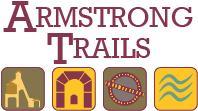Rails to Trails Movement
The rail-trail idea began in the 1960’s. Primarily in the Midwest, people began to advocate converting unused railroad lines to recreational trails. In 1983, Section 8(d) of the National Trail Systems Act was amended by Congress to allow unused rail corridors to be used for recreational trails and to be preserved for future railroad use under a provision called railbanking. This legislation was challenged, but on December 17, 1990, the Court upheld the railbanking legislation.
On February 19, 1993, the Armstrong Rails to Trails Association incorporated as a nonprofit membership organization. Goals were to promote the conversion, maintenance and management of the right-of-way into the Armstrong Trail for recreational use. Armstrong Rails to Trails Association organized trail maintenance, rides, fundraisers and clean ups.
In 1995, a lawsuit was filed against AVLT in Armstrong County Court of Common Pleas claiming that certain properties reverted back to the adjacent land owners because it was abandoned by the railroad and no longer had a Railroad Use. This became known as Moody vs AVLT.
In 2005, after several decisions an appeals Judge Carson Brown issued a judgement in favor of Moody citing their arguments “are more persuasive”.
June 2007, PA Superior Court stated the 2005 judgement was incorrect and AVLT is a qualified organization and can privately railbank, was properly railbanks and preserves the corridor for future railroad use.
